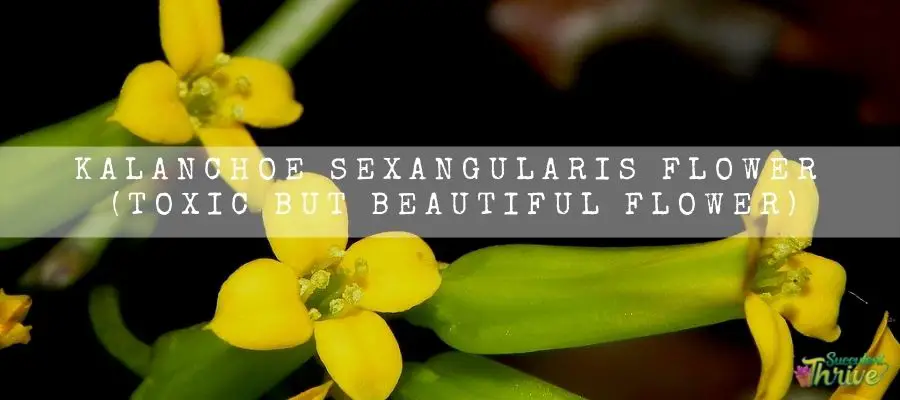Kalanchoe Sexangularis flower is very attractive toward pollinators and they are eye-catching yellow in color. Their flowering season falls in spring. It will be pleasing to see them blooming no matter where you plant them be it indoors or outdoors.
To briefly touch on the plants, they are quite famous as decorative plants. Kalanchoe Sexangularis can be used to grow in lowlight levels as well.
These are native plants in South Africa. Kalanchoe Sexangularis would be great picks for beginners in gardening too.

How often do Kalanchoe Sexangularis flowers?
Kalanchoe Sexangularis would usually produce flowers in spring.
When they grow in their natural habitat, Kalanchoe Sexangularis will start to blossom during the beginning of spring. Hence, they are called short day plants.
Colors of Kalanchoe Sexangularis flowers
Kalanchoe Sexangularis blooms are yellow and tend to take a tubular shape.
How long do Kalanchoe Sexangularis flowers last?
Generally, the blooms of the Kalanchoe Sexangularis would stay alive for several weeks. Having said that, chances are that they could stay alive for several months as well.
Do they die after flowering?
No Kalanchoe plants do not die after flowering. They can flower many times they perish if you treat the plant well.
How to make Kalanchoe Sexangularis flowers?
It is important that they get at least 13 hours of darkness to flower.
In addition to that ensure that you provide the right temperature levels also for them to bloom. When you spot them forming flower buds, you need to shift them to a brighter place and continue with regular watering.
Consider applying fertilizers during spring. If you adhere to these guidelines, you will see how they form attractive flowers.
I recommend getting rid of the spent blooms so that it will stimulate new buds.
How to care for Kalanchoe Sexangularis flower?
Sunlight
Kalanchoe Sexangularis require bright indirect sunlight to thrive well. Having said that they could manage to perform well in partial shade as well.
This is something which is different to other succulents in general. So, if you have outdoor grown Kalanchoe Sexangularis, you need to ensure that they are exposed to full sunlight in the morning and partial shade in the afternoon.
It is important that you expose the plants to adequate sunlight so that the plants can grow vigorously, and it will ensure a healthy growth in the plants as well as in the flowers.
Do not leave the plants under intense harsh sunlight as it could be harmful for the plants.
Soil medium
It is important that your Kalanchoe Sexangularis plants are grown in a well-draining soil mix so that there will be no excess moisture retaining in the soil after a watering session.
You could easily proceed with a succulent soil mix or in a cactus soil mix to grow them. Alternatively, you could prepare a soil mix on your own by blending 40 % – 50 % sand with peat moss.
How to water the Kalanchoe Sexangularis
Kalanchoe Sexangularis used to grow in hot and dry weather conditions when they grew in their natural habitat.
Hence, they would thrive well with moderate watering. You do not need to keep them wet at any given time. What is crucial is to water them thoroughly and less often.
Once you complete watering them, you need to make sure that no excess moisture is retained in the pot and it is dry.
Usually, it would be safer to water them once every fortnight. Having said that you may have to change the frequency in watering them depending on the temperature, light levels, season and on the pot size as well.
Usually, you need to water the Kalanchoe Sexangularis plants more frequently than what you do in winter and fall.
Keep in mind not to let any water retain in the pot as if you do so, it would make your Kalanchoe Sexangularis plants vulnerable to diseases such as root rot.
It is so crucial that you water the Kalanchoe Sexangularis well so that the flowers of the plants can also grow well and healthily.
Fertilization
Kalanchoe Sexangularis are not dependent on fertilizers. Instead, they could perform well with the nutrients available in the potting medium.
However, you could consider using a manufacturer’s recommended fertilizer so that it will provide an extra boost for the growth of the plants.
You may feed them once every two weeks or even once every month during their active growing season. Suspend feeding them when they are in their dormancy.
Ideal Pot requirement
Ensure that you grow them in a porous material so that the moisture within the pot could evaporate faster.
Best is to use an unglazed pot or a terracotta pot so that the excess moisture could evaporate faster.
In addition to that ensure the selected pot has at least one draining hole in the bottom so that the excess water can move through.
Temperature levels
These plants are tolerant of warmer temperatures. However, they would perform well in room temperatures too.
You could grow them outdoors if you do not expect any extreme winter weather conditions.
However, if you have grown the plants outdoors and if any extreme winter weather condition is predicted, you need to shift the plants indoors to protect them from such unhealthy conditions.
Conclusion
Before wrapping this article up, I hope you found it useful.
To sum up, Kalanchoe Sexangularis flowers are attractive, yellow-colored flowers and it would be so pleasing to watch them when they are in full blossom.
I recommend trimming off the spent blooms so that it would stimulate new growth in the plants.
Read Next : Does The Lifesaver Plant Flower? (Yes They Are)
